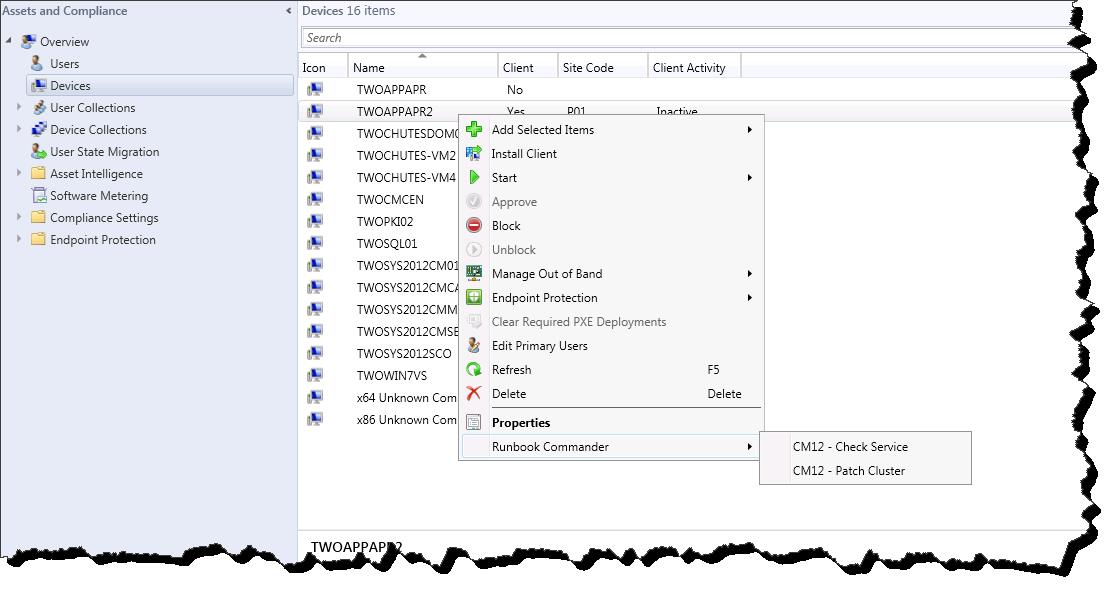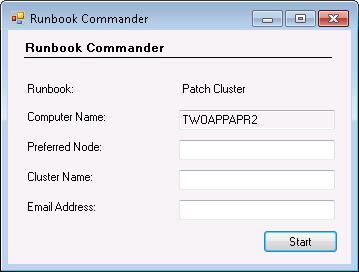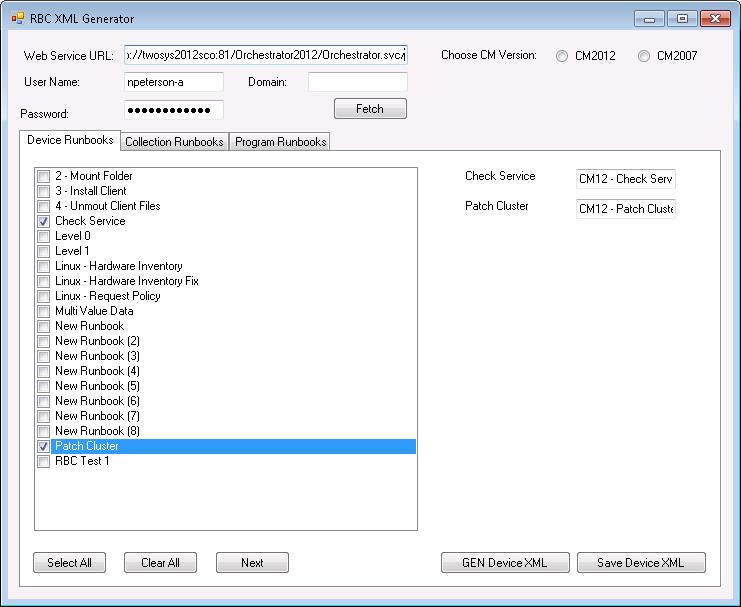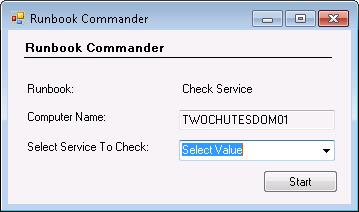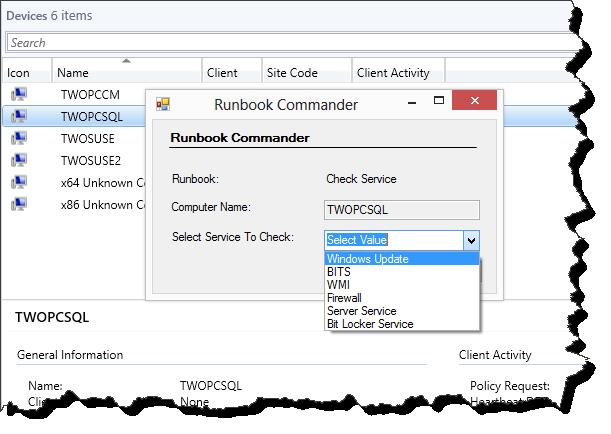Runbook Commander 2.0 – System Center Orchestrator Console Extension for Configuration Manager
Many months ago I made available Runbook Commander: An Orchestrator Console Extension for Configuration Manager. I am pleased to announce that today version 2.0 has been posted to the TechNet Gallery for download. I have added many features (some significant) to version 2, all of which will be summarized in this blog posting. I will be following up rather quickly with a complete configuration and administration guide, be on the lookout for that. As always if you enjoy this posting feel free to leave some feedback or reach out to me directly.
Runbook Commander 2.0 Download - Runbook Commander 2.0
Runbook Commander 2.0 Deployment and Administration Guide - Deployment and Administration Guide
What is Runbook Commander -
Runbook Commander is a dynamic console extension for Configuration Manager that allows for console initiated execution of Orchestrator Runbooks. Once installed and configured, the Configuration Manager console user will have the ability to right click on a computer, collection, or program (figure 1) and execute one of many predetermined Orchestrator Runbooks against the selected Configuration Manager object. A form is dynamically created to reflect any input parameters specified in the target Runbook (figure 2). The values entered into each parameter control including that of the selected Configuration Manager object (Computer Name, Collection ID, or Program Name) will then be passed to the target Runbook, and the Runbook will be executed.
Included with Runbook Commander 2.0 is an application that will aid in the predetermining of what Runbooks to make available to the console extensions. This application will also auto create the appropriate Configuration Manager Console extension XML files. The RBC XML Generator tool (figure 3) will discover all Runbooks from the Orchestrator environment that meet the prerequisites for execution from Configuration Manager. RBC XML Generator will then allow you to manually pick which of these to include in your custom console extensions and give them a friendly display name. The tool then creates and places the Configuration Manager XML in the appropriate location. Additionally RBC XML Generator will allow you to save off the custom XML for an automated deployment experience.
Figure 1 – Console Extension Menu
Figure 2 - Dynamically Generated Form
Figure 3 – RBC XML Generator Tool
What is new to version 2 -
Here is a list of the new features to V2.0. Most of the new goodness focuses around the installation experience and platform supportability; however there are a few functional changes as well. Please stay tuned for a second post which will contain the configuration and administration guide.
Support for Configuration Manager 2007 – RBC 2.0 now supports both Configuration Manager 2007 and 2012 Configuration Manager. Additionally when deploying Runbook Commander bundled with pre-created XML files the installer will determine what version on Configuration Manager Console is being used and appropriately stage the XML extensions files.
New XML Generator Tool – RBC requires custom XML files to be created for each environment. These XML files control which Orchestrator Runbooks are available for execution from the Configuration Manager environment. The new XML Generator tool handles the XML creation for Configuration Manager 2007 and 2012 Configuration Manager. This tool now also allows saving off XML files for use in a pre-staged deployment (see next bullet point). Finally the XML GEN tool has been redesigned for an easier interactive experience (Refer back to Figure 3).
New Installer – with RBC version 1.0, the installer basically staged the computer for use with RBC. It was then up to the individual to run the XML generator tool on each machine in order to create the console extension. Alternatively the XML files could have been manually (or scripted) copied to the appropriate location on the target computer. New to version 2.0, the console extensions XML files can be pre-created and then deployed with RBC allowing for a single and automated installation experience across many computers.
Replace XML Application – RBC 2.0 includes a new application that can be deployed to computers which will replace the console extensions XML. In the situation where new Runbooks need to be added to the RBC console extension menu or old Runbooks need to be removed, the custom XML would be created using the XML generator tool and then deployed to all machines with the Replace XML application. The replace XML application will appropriately replace the console extension XML and at next launch the Configuration Manager console will be loaded with the updated set of Runbooks.
Console Extensions to the Program Node – RBC Version 1.0 had support for consoles extensions to devices and collections. I had received a request to add programs, which has been completed. I will add more console items as time permits with priority going to those requested.
Drop Down Lists – Added to version 2.0 is the ability to dynamically create drop down lists as parameter values (Figure 4). This will allow the Runbook administrator to provide a list of values on the actual Runbook. These values will then be available from RBC at execution time from the Configuration Manager console. I will detail the creation of these in the soon to complete full documentation.
Fixed IIS Paging Limitation – The Orchestrator Web Service contains a paging mechanism which allows only 50 Rubooks (or other objects) to be retuned at query time. With RBC 1.0 the XML Gen tool would not return all available Runbooks without making modification to the IIS Web Service application settings. The XML GEN 2.0 includes code that gets around the paging feature and will now present all Runbooks at execution time.
Removed Start Menu Shortcuts – As RBC is for the most part initiated from within the Configuration Manager console, all start menu shortcuts have been removed. This does mean that if using the XML generator application you will need to navigate to the installation folder and execute directly. This process will be detail in the forthcoming configuration and deployment guide.
Figure 4 - Dynamically Created Drop Down List
Conclusion –
I have put allot of work into this project and am excited to be able to finally bring it to a release. I hope that RBC 2.0 continues to bring value in the event you are using 1.0. If you are new to RBC I hope that this bring new value and time saving automation to your administration experience. Please look for the full configuration and administration guide which should be released within the next day or so. Please subscribe to my Twitter feed to receive a notification of when the guide has been published (subscribe button is to the right). If you have any questions or requests, please leave your comments here or contact me through email.
